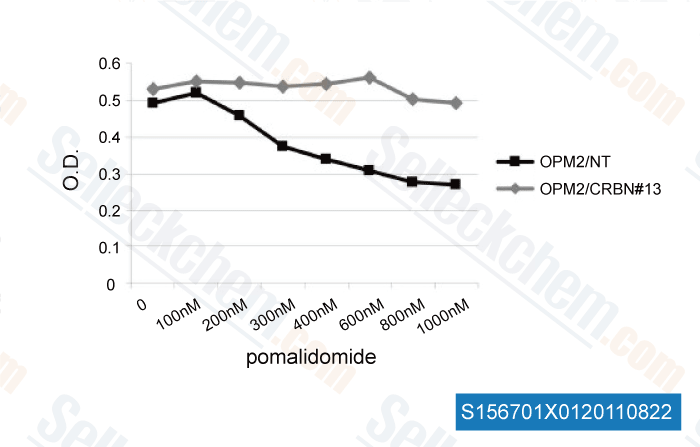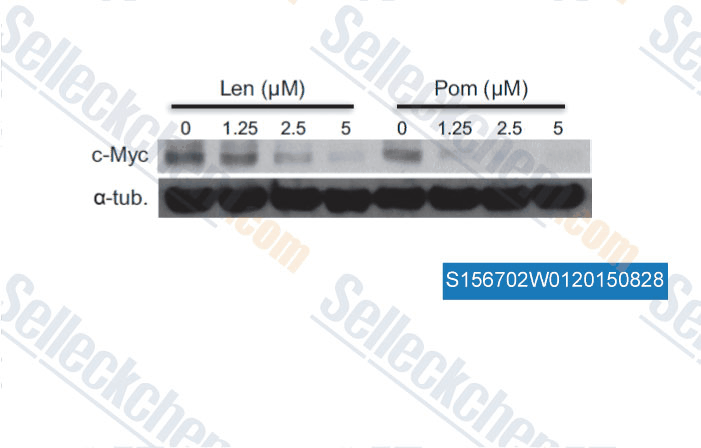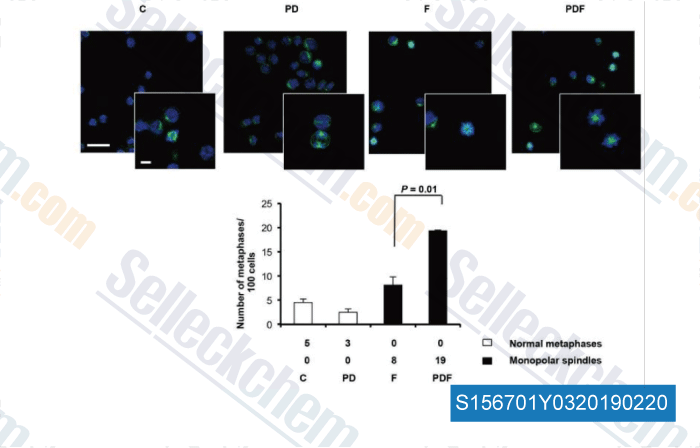|
Toll Free: (877) 796-6397 -- USA and Canada only -- |
Fax: +1-832-582-8590 Orders: +1-832-582-8158 |
Tech Support: +1-832-582-8158 Ext:3 Please provide your Order Number in the email. |
Technical Data
| Formula | C13H11N3O4 |
|||
| Molecular Weight | 273.24 | CAS No. | 19171-19-8 | |
| Solubility (25°C)* | In vitro | DMSO | 54 mg/mL (197.62 mM) | |
| Water | Insoluble | |||
| Ethanol | Insoluble | |||
|
* <1 mg/ml means slightly soluble or insoluble. * Please note that Selleck tests the solubility of all compounds in-house, and the actual solubility may differ slightly from published values. This is normal and is due to slight batch-to-batch variations. * Room temperature shipping (Stability testing shows this product can be shipped without any cooling measures.) |
||||
Preparing Stock Solutions
Biological Activity
| Description | Pomalidomide inhibits LPS-induced TNF-α release with IC50 of 13 nM in PBMCs. Pomalidomide can be utilized in PROTAC as a ligand for targeting E3 ligase and inhibiting the E3 ligase protein cereblon (CRBN). Pomalidomide promotes apoptosis and cell cycle arrest. | ||||
|---|---|---|---|---|---|
| Targets |
|
||||
| In vitro | Pomalidomide inhibits lipopolysaccharide (LPS) stimulated TNF-alpha release in human PBMC and in human whole blood with IC50 values of 13 nM and 25 nM, respectively. [1] Pomalidomide inhibits the growth of T regulatory cells which is stimulated by IL-2 with an IC50 of ~1 μM. [2] Treatment with Pomalidomide (6.4 nM-10 μM) increases the production of IL-2 in human peripheral blood T cells, and is slightly more potent in the CD4+ subset than in the CD8+ subset. Pomalidomide is significantly more potent than CC-5013 at elevating IL-2, IL-5, and IL-10 levels, but only slightly more potent than CC-5013 at elevating IFN-γ levels. Pomalidomide enhances SEE and Raji cells induced AP-1 transcriptional activity in Jurkat cells in a dose-dependent manner, with a maximal enhancement of 4-fold at 1 μM. [3] Exposure of Raji cells to various concentrations of Pomalidomide (2.5-40 μg/mL) for 48 hours leads to a significant decrease in cell proliferation and DNA synthesis. There is a reduction of ~40% compared to vehicle-treated controls. [4] |
||||
| In vivo | Pomalidomide enhances the antitumor effect of rituximab against B-cell lymphomas in severe combined immunodeficient mice. Administration of Pomalidomide in combination with rituximab, gives the mice a median survival period of 74 days compared with 58 days of CC5013/rituximab treatment and 45 days of rituximab nonotherapy. The synergistic effect of Pomalidomide and rituximab can be completely abrogated by depletion of NK cells, supporting the proposal that NK cell expansion is one mechanism by which Pomalidomide may augment rituximab antitumor activity. [4] |
||||
| Features | A derivative of thalidomide and up to 10,000 times more potent than thalidomide. |
Protocol (from reference)
| Kinase Assay: |
|
|---|---|
| Cell Assay: |
|
| Animal Study: |
|
References
Customer Product Validation

-
Data from [Blood, 2011, 118, 4771-4779]

-
Data from [Data independently produced by , , Blood Cancer Journal, 2015, 5: e312]

-
Data from [Data independently produced by , , Haematologica, 2017, 102(12):2113-2124]
Selleck's Pomalidomide has been cited by 106 publications
| Targeting the mSWI/SNF Complex in POU2F-POU2AF Transcription Factor-Driven Malignancies [ bioRxiv, 2024, :2024.01.22.576669.] | PubMed: 38328238 |
| BRD4-targeting PROTAC as a unique tool to study biomolecular condensates [ Cell Discov, 2023, 9(1):47] | PubMed: 37156794 |
| SUMOylation inhibition overcomes proteasome inhibitor resistance in multiple myeloma [ Blood Adv, 2023, 7(4):469-481] | PubMed: 35917568 |
| Daratumumab induces cell-mediated cytotoxicity of primary effusion lymphoma and is active against refractory disease [ Oncoimmunology, 2023, 12(1):2163784] | PubMed: 36632565 |
| CD38-Induced Metabolic Dysfunction Primes Multiple Myeloma Cells for NAD+-Lowering Agents [ Antioxidants (Basel), 2023, 12(2)494] | PubMed: 36830052 |
| Exosome-Modified Liposomes Targeted Delivery of Thalidomide to Regulate Treg Cells for Antitumor Immunotherapy [ Pharmaceutics, 2023, 15(4)1074] | PubMed: 37111560 |
| Novel dual LSD1/HDAC6 inhibitor for the treatment of cancer [ PLoS One, 2023, 18(1):e0279063] | PubMed: 36595522 |
| Vactosertib, a novel TGF-β1 type I receptor kinase inhibitor, improves T-cell fitness: a single-arm, phase 1b trial in relapsed/refractory multiple myeloma [ Res Sq, 2023, rs.3.rs-3112163] | PubMed: 37503043 |
| Proteogenomics refines the molecular classification of chronic lymphocytic leukemia [ Nat Commun, 2022, 13(1):6226] | PubMed: 36266272 |
| Proteogenomics refines the molecular classification of chronic lymphocytic leukemia [ Nat Commun, 2022, 13(1):6226] | PubMed: 36266272 |
RETURN POLICY
Selleck Chemical’s Unconditional Return Policy ensures a smooth online shopping experience for our customers. If you are in any way unsatisfied with your purchase, you may return any item(s) within 7 days of receiving it. In the event of product quality issues, either protocol related or product related problems, you may return any item(s) within 365 days from the original purchase date. Please follow the instructions below when returning products.
SHIPPING AND STORAGE
Selleck products are transported at room temperature. If you receive the product at room temperature, please rest assured, the Selleck Quality Inspection Department has conducted experiments to verify that the normal temperature placement of one month will not affect the biological activity of powder products. After collecting, please store the product according to the requirements described in the datasheet. Most Selleck products are stable under the recommended conditions.
NOT FOR HUMAN, VETERINARY DIAGNOSTIC OR THERAPEUTIC USE.
